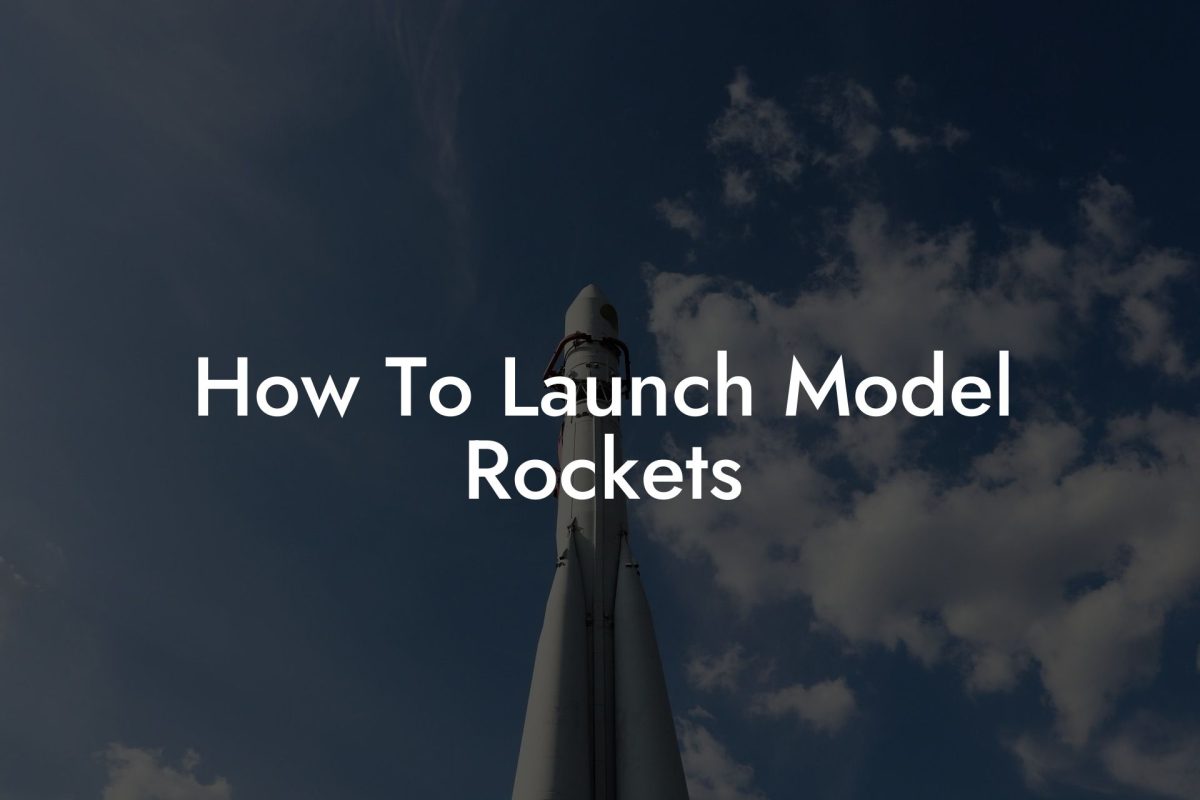Imagine soaring to new heights with your model rocket, defying gravity and pushing the boundaries of innovation. But, have you ever wondered what makes your rocket stable and efficient? Welcome to the world of model rocket stability, where aerodynamics, physics, and design come together to create a thrilling experience.
Quick Links to Useful Sections
What is model rocket Stability?
Stability refers to a model rocket's ability to maintain its flight path and orientation, resisting external disturbances like wind, air resistance, and gravity. A stable rocket ensures a smooth, predictable, and safe flight, while an unstable one can lead to a crash or loss of control.
There are three types of stability in model rockets: static, dynamic, and spiral. Static stability refers to the rocket's ability to return to its original position after being disturbed. Dynamic stability involves the rocket's response to continuous disturbances, like turbulence. Spiral stability is the combination of static and dynamic stability, ensuring the rocket follows a consistent, predictable path.
The Pillars of Model Rocket Stability
A stable model rocket relies on several key factors, which work together to ensure a successful flight:
- Aerodynamics: The shape and design of the rocket influence its aerodynamic characteristics, such as drag, lift, and thrust. A well-designed rocket can reduce air resistance and improve stability.
- Center of Gravity (CG) and Center of Pressure (CP): The CG is the point where the rocket's weight is concentrated, while the CP is the point where the aerodynamic forces act. A stable rocket has a CG located above the CP.
- Mass Distribution: The distribution of mass within the rocket affects its stability. A balanced rocket with a low center of gravity is more stable than one with a high CG.
- Fin Design and Configuration: The size, shape, and arrangement of the fins influence the rocket's stability and control. Well-designed fins can improve stability and reduce wobble.
- launch and Recovery Systems: A reliable launch system and a well-designed recovery system, such as a parachute or streamer, ensure a safe and stable flight.
By understanding and optimizing these factors, you can design and build a model rocket that soars to new heights with precision and control.
Looking For The Best Model Rocket Kits? You'll Love These:
Designing for Stability: Tips and Tricks
When designing your model rocket, keep the following tips in mind to ensure stability and success:
- Keep it Simple: Avoid complex designs and focus on simplicity and symmetry.
- Balance is Key: Ensure the rocket's mass is evenly distributed to maintain a low center of gravity.
- Fin-tastic: Use large, symmetrical fins to improve stability and reduce wobble.
- Aerodynamic Shape: Opt for a streamlined shape to reduce air resistance and improve stability.
- Test and Refine: Conduct thorough testing and refine your design based on the results to ensure optimal stability.
By following these guidelines, you can create a model rocket that not only looks amazing but also flies smoothly and efficiently.
Common Stability Issues and Solutions
Even with careful design and construction, stability issues can arise. Here are some common problems and their solutions:
- Wobble or Spin: Check the fin alignment and adjust as needed. Ensure the rocket's mass is evenly distributed and the CG is above the CP.
- Unstable Flight: Verify the rocket's aerodynamics, checking for any irregularities or defects. Adjust the fin design or shape to improve stability.
- Loss of Control: Inspect the launch system and recovery system for any malfunctions. Ensure the rocket's electronics and guidance systems are functioning correctly.
By identifying and addressing these common issues, you can troubleshoot and resolve stability problems, ensuring a successful and enjoyable flight.
Resources and community Support: Your Next Steps
Join the model rocket community and take your skills to the next level with these resources:
- Online Forums and Groups: Connect with fellow model rocket enthusiasts, share knowledge, and learn from others.
- Tutorials and Guides: Access comprehensive tutorials and guides on model rocket design, construction, and flight.
- Local Clubs and Meetups: Join local model rocket clubs and attend meetups to network with like-minded individuals and learn from their experiences.
- Competitions and Events: Participate in model rocket competitions and events to showcase your skills and learn from others.
With these resources, you'll be well on your way to becoming a model rocket expert, designing and flying stable, efficient, and awe-inspiring rockets.
Frequently Asked Questions: Model Rocket Stability
Here are some frequently asked questions about model rocket stability:
1. What is the most important factor in model rocket stability?
The most important factor is the relationship between the Center of Gravity (CG) and the Center of Pressure (CP). A stable rocket has a CG located above the CP.
2. How do I ensure my model rocket is stable during flight?
Ensure the rocket's mass is evenly distributed, the fins are symmetrical and well-designed, and the aerodynamics are optimized for stability.
3. What is the difference between static and dynamic stability?
Static stability refers to the rocket's ability to return to its original position after being disturbed, while dynamic stability involves the rocket's response to continuous disturbances.
4. Can I use a parachute or streamer to improve stability?
Yes, a well-designed recovery system, such as a parachute or streamer, can improve stability during descent and landing.
5. How do I troubleshoot stability issues with my model rocket?
Identify the problem, inspect the rocket's design and construction, and make adjustments as needed to ensure optimal stability.
Looking For The Best Model Rocket Kits? You'll Love These:
Useful Interruption: Dive deeper into the world of Model Rockets with our most popular sections. If there is anything you think is missing or anything you would love for us to write about, just give us a shout.
- Getting Started & Basics With Model Rockets
- Model Rocket Design, Build & Customization
- Model Rocket Propulsion & Engine Technology
- Model Rocket Launch Techniques & Recovery
- Model Rocket Advanced Rocketry & Innovations
- Model Rocket DIY and Customization
- Model Rocket Equipment Reviews & Digital Tools
- Community, Competitions & Education
- Model Rocket Troubleshooting & FAQs
- Model Rocket Bonus/Seasonal & Niche Topics
A group of model rocket enthusiasts gathered at a field for their weekly launch event. Among them was Dave, a seasoned builder known for pushing the limits of hobby rocketry. This time, he had outdone himself.
“Ladies and gentlemen,” Dave announced, dramatically pulling a cloth off his latest creation, “I present to you: The Kraken!”
The crowd gasped. This wasn’t just a model rocket, it was a monster. The thing stood 8 feet tall, had six clustered engines, and was covered in enough duct tape to qualify as a classified aerospace project.
“Dave,” muttered Steve, the cautious safety officer, “Have you, uh… done the math on this?”
“Math?” Dave scoffed. “I built it in my garage at 3 a.m. with parts from eBay. This is an art piece, Steve.”
The countdown began.
5…
4…
3…
2…
1…
The engines ignited with a BOOM, and The Kraken shot up… kind of. It immediately did a violent barrel roll, narrowly missing the spectators before skyrocketing at an angle that could only be described as “legally questionable.”
The crowd collectively ducked as The Kraken flew straight over the adjacent cornfield, where Old Man Jenkins, the grumpiest farmer in town, was minding his business.
KABOOM!
The rocket disappeared behind the barn. A moment later, a flaming piece of Estes igniter wire landed at Steve’s feet. The silence was deafening.
And then, an unmistakable sound echoed across the field.
Jenkins’ shotgun being cocked.
“DAVE!!!” Steve shouted. “RUN.”
And that was the day Dave invented the first-ever biologically powered rocket booster: pure adrenaline.
To this day, nobody knows where The Kraken landed, but legend has it, it still haunts the skies, terrifying unsuspecting drones and low-flying birds.















